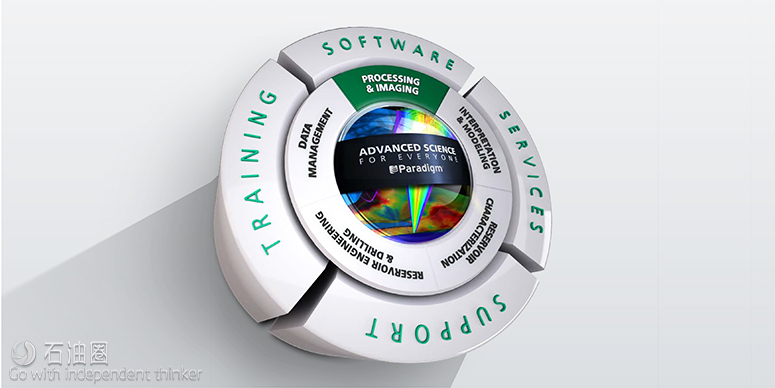Up to 50% of the subsurface information obtained from seismic data is believed to be either underutilized or lost using standard seismic imaging procedures. These imaging procedures remain biased towards high energy events defined by continuous reflectors or major discontinuities such as large faults. This energy is referred to as “specular” energy, and typically dominates the seismic data volumes used by seismic interpreters. While image processing techniques like coherency and volumetric curvature can help recover or enhance discontinuities in the seismic data, they cannot recover the high-resolution and lower energy details that have already been masked by standard processing and imaging procedures.
A significant amount of energy associated with high-resolution features such as small faults, stratigraphic edges and reservoir heterogeneities is recorded in the form of “diffraction” energy. The information encoded in diffraction energy can help explain reservoir compartmentalization, permeability and performance. It is this information that is masked by the dominant specular energy and irretrievably lost through the integration and stacking processes that are employed in standard seismic processing and imaging procedures. While these standard procedures improve signal-to-noise ratios, they do not recover the detail that can resolve subsurface complexities, influence prospectively decisions, or control reservoir behavior.
The innovative Paradigm EarthStudy 360® system is able to both recover and separate specular and diffraction energy from recorded seismic data. The process decomposes the fully recorded seismic wavefield in-situ and in depth, without integration or stacking, so that the lower energy associated with subsurface diffractions can be isolated and subsequently enhanced.
Expanding the Frontiers of Subsurface Exploration
Paradigm® EarthStudy 360 is an innovative new system designed to deliver to both depth imaging experts and interpretation specialists a complete set of data that enables them to obtain accurate subsurface velocity models, structural attributes, medium properties and reservoir characteristics. The system extracts unprecedented value from all modern and legacy seismic data acquisitions, especially those with wide and rich azimuth and long offset, in both marine and land environments.
EarthStudy 360 is most effective for imaging and analysis in unconventional gas plays within shale formations and in fracture carbonate reservoirs. The system delivers highly accurate images from below complex structures, such as shallow low-velocity anomalies like gas pockets, subsalt, sub-basalt and high-velocity carbonate rocks. These result in optimal solutions for anisotropic tomography and for fracture detection and reservoir characterization.
Added Value for Geoscientists
EarthStudy 360 creates a wealth of seismic image data, decomposed into full-azimuth, angle-dependent reflection and directional (dip and azimuth) data components. These can be selectively sampled, creatively combined, dynamically visualized, and further processed to secure images of the subsurface. The images can reveal the information needed for velocity model determination, as well as provide details regarding the presence of micro-fractures, the orientation of faults and fractures, the influence of anisotropy, the directions of contributing illumination, the elastic properties of target reservoirs, and the boundaries of those reservoirs.
EarthStudy 360 enables geophysicists to use all recorded seismic data in a continuous fashion directly in the subsurface local angle domain. This results in two complementary, full-azimuth, 3D angle gather systems: Directional and reflection.
Directional angle decomposition implements both specular and diffraction imaging with real 3D isotropic/ anisotropic geological models, leading to simultaneous emphasis on both continuous structural surfaces and discontinuous objects such as small faults and smallscale fractures. Structural attributes at each subsurface point, such as dip, azimuth and continuity, can be reliably derived directly from the directional angle gathers.
EarthStudy 360 reflection angle gathers provide “true amplitude” reflectivities that substantially increase the information needed to extract residual moveouts (RMO) and amplitude variations. The full-azimuth, angle domain RMO enables accurate velocity model determination (isotropy/anisotropy tomography). Full-azimuth, angle domain amplitude variations result in better reservoir characterization, with high-resolution elastic properties and high-resolution fracture determinations.
Hidden structure revealed by EarthStudy 360
Directional angle gather near geologic pinchout: Two specular signature directions at same location
New Technologies for a New Age Declining production in mature oil and gas fields is forcing upstream energy companies to explore areas of increasing operational and technical complexity. Existing solutions for extracting information about the subsurface geological model are limited, and there is a need to expand current technologies to include the acquisition of wide and rich azimuth seismic data. Paradigm is the first to meet this need with EarthStudy 360, a new invention designed to image, characterize, visualize and interpret the total seismic wavefield.
EarthStudy 360 Imager
The EarthStudy 360 Imager is a cluster-based solution that efficiently uses the full recorded wavefield to generate 3D full-azimuth, directional and reflection angle gathers. The Imager can be utilized to provide fast, target-oriented solutions for local analysis, and can also be used for imaging on a regional scale.
EarthStudy 360 Tomography
The tomography system uses input data extracted from EarthStudy 360 directional (directivity) and reflection (fullazimuth RMO) gathers to update the velocity model. The substantial increase in information about the subsurface improves accuracy and reduces uncertainty. This is especially important when determining anisotropy model parameters.
EarthStudy 360 uses both directional and reflection angle gathers to image and detect subsurface local heterogeneities such as small faults and fine fractures. Diffraction weighted stacks applied to directional angle gathers enable high-resolution imaging of the fracture system within the reservoir. Azimuthal-dependent residual moveouts (VVAZ) and amplitude variations (AVAZ), which can be automatically extracted from the full-azimuth reflection angle gathers, provide accurate information about the orientation and density of fracture systems.


 石油圈
石油圈
